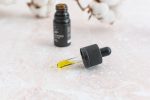A lot of research has been conducted trying to understand how cannabinoids like cannabidiol, or CBD oil, work inside the body. The result is the recognition of a system of neurotransmitters and receptors called the Endocannabinoid System (ECS).
This system is composed of cannabinoid receptors, endocannabinoids and the enzymes that make or break down the endocannabinoids. All components need to be present to maintain many of the body’s normal functions, but much of how the system works is still the basis of ongoing study.
Cannabinoid Receptors
Receptors sit on various parts of the body’s cells to receive messages from other parts of the body. Once a neurotransmitter binds to a receptor, a cascade of effects is initiated until the message is stopped when the neurotransmitter unbinds to the receptor. Cannabinoid receptors are found throughout the body and are mostly expressed on cell wells, although a few subtypes have been found inside cells. The two most common types of cannabinoid receptors researched so far are CB1 and CB2 receptors.
A Brief Breakdown of CB1 Receptors
CB1 receptors are found mostly in the central nervous system, especially the brain, and are involved in various neurological activities. As a result, these receptors have been found to be involved in basic, physiological functions including learning and memory, motor function and pain regulation. This receptor type is the focus of potential treatment for neurodegenerative diseases like Alzheimer’s, Parkinson’s and Huntington’s diseases.
CB1 receptors have been found in other organs and parts of the body as well. Because of their widespread presence, CB1 receptors play important physiological roles in metabolism, appetite and digestion, reproductive and cardiovascular functions, inflammation and so much more. Targeting CB1 receptors as a way to treat certain diseases is made more difficult because of the high chance of creating various, unintended side effects.
A Brief Breakdown of CB2 Receptors
CB2 receptors are found mostly in the cells that make up the immune system. However, they have also been found in other tissues and organs elsewhere in the body, including the brain, though in much fewer numbers than CB1 receptors. Activation of CB2 receptors help moderate the body’s immune response to pathogens, inflammation and pain regulation. Because these receptors are not as abundant as CB1 receptors, targeting these receptors may be more practical in treating certain diseases with less chance of side effects.
What Are Endocannabinoids?
Cannabinoids act on many types of receptors, including cannabinoid receptors, and therefore have therapeutic potential in the body. The psychoactive effects of some synthetic and plant-based cannabinoids has limited their use in clinical practice.
Research has grown in regards to studying the cannabinoids that the body is able to make itself, or endocannabinoids. These neurotransmitters carry chemical messages throughout the endocannabinoid system. When endocannabinoids bind to receptors, a cellular response is initiated, which stops only when the neurotransmitter is broken down by the cell. This frees the receptor to react with another chemical and keeps a single reaction from continuing on indefinitely.
The two most widely studied endocannabinoids are anandamide (ANA) and 2-arachidonoylglycerol (2-AG). Most cannabinoids, including endocannabinoids, can bind to both CB1 and CB2 receptors as well as other non-endocannabinoid receptors, although their affinity for different receptors may differ in cell types. The type of response that takes place after binding will depend on the type and location of receptor being activated.
ANA operates throughout the endocannabinoid system and is involved in different physiological functions, including appetite, memory, pregnancy and more. In contrast, 2-AG has been associated with emotional states, maintaining cardiovascular health and protection from seizures. Other studies have shown that cannabinoids are involved in the regulation of different types of pain, including chemical, mechanical and heat pain, as well as neuropathic, inflammatory and cancer pain. When you buy CBD oil to supplement your own ECS, you’re helping to maintain homeostasis within your body.
The endocannabinoid system is complex in its interactions with the rest of the body. The potential for creating treatments for a number of conditions and ailments is tremendous. Further research will show the benefits of targeting the various components of the endocannabinoid system in medical therapy.
















